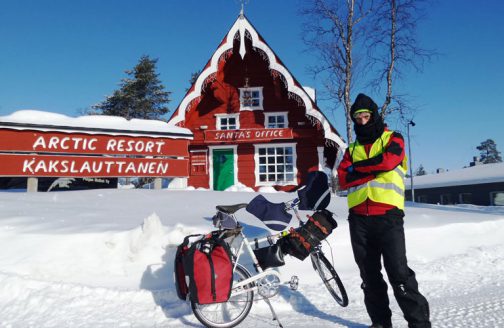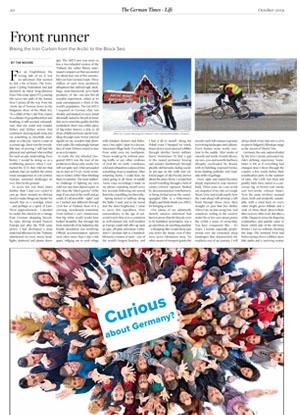Front runner: Biking the Iron Curtain from the Arctic to the Black Sea

For an Englishman the wrong side of 50, it was an adventure that seemed to tick a lot of boxes. The European Cycling Federation had just declared its latest long-distance Euro Velo route open: EV13, tracing the 9,000-km path of the former Iron Curtain all the way from the Arctic tip of Norway down to the Bulgarian shore of the Black Sea. To a child of the Cold War, reared in a climate of geopolitical fear and loathing, it still seemed extraordinary that one could now wander hither and thither across that continent-cleaving death strip, and on something as cheerfully mundane as a bicycle. And to a man of a certain age, there was the irresistible lure of proving I still had the physical and spiritual wherewithal for such an epic undertaking. Even better, I would be doing so as a trailblazing pioneer: when I contacted the ECF, they told me that nobody had yet tackled the entire route unsupported. In 21st-century Europe, untamed challenges lie very thin on the ground.
As 9,000 km was three times further than I had ever cycled in one go, there seemed no obvious need to make things any harder for myself. But on a nostalgic whim – and perhaps in a spirit of East- West rapprochement – I decided to tackle this mission on a vintage East German shopping bicycle. In 1990, driving around Eastern Europe just after the Wall came down, I had developed a deep maternal affection for the Trabants abandoned on every street, headlights shattered and plastic doors ajar. The MIFA 900 was more or less a two-wheeled version of the Trabant, the rather flimsy, state-issued compact car that accounted for about four out of five automobiles on East German roads. Three million of each were produced, ubiquitous but unloved ugly ducklings, semi-functional, jerry-built products of the one-size-fits-all socialist experiment, which at its peak encompassed a third of the world’s population. The €56 MIFA I acquired on German eBay was shoddy and stunted, in every detail abysmally suited to the job at hand. But never mind the quality, feel the symbolism: there was a little piece of big-ticket history, a link to all those childhood hours spent twiddling through eerie Soviet interval signals on my wooden-clad shortwave radio, the endearingly human face of what I’d been reared to fear as an evil empire.
In truth, the tiny-wheeled, two-geared MIFA was the least of my problems in those early weeks. I’m still not quite sure what persuaded me to start at EV13’s Arctic terminus in winter, rather than finishing there in summer. The more authentic challenge of fighting my own cold war may have played a part, as did, I fear, the “idiot’s gravity” of the map: if you start at the north and go south, it’s all downhill – right? And so I inched and slithered through 1,700 km of Finland, most of it a yawning, snowbound wasteland. From behind a car’s windscreen, that big white world would have looked beautiful. But through the frost-rimed slit of my balaclava, the hostile desolation was terrifying. Official accommodation options were often more than a day’s ride apart, obliging me to seek refuge with reindeer farmers and fishermen. One night I slept in a decommissioned village bank. Everything froze solid, even my toothpaste. Hours would go by without passing traffic or any other evidence of rival life on earth. Loneliness, cold and exhaustion coalesced into something close to madness. After returning home, I could hear my mind going in all those in-saddle Arctic voice recordings I made on my phone: repeating myself every few seconds, bellowing out surreal limericks, mumbling incoherently.
Spring kicked in halfway along the Baltic Coast, and as my mood and the skies brightened, I came to savor this expedition. How extraordinary, in the age of universal travel, that even a continent as well-charted and well-trodden as Europe could still offer up such an epic, off-piste adventure. Lithuania’s Curonian Spit is a hundredkilometer comma of sand – one of the world’s longest beaches, and I had it all to myself. Along the Polish coast I bumped for lonely hours down weed-pierced cobbles through derelict Soviet military bases. Sometimes I’d find a gap in the rusted perimeter fencing and wander dumbstruck through ghostly old barracks, fading socialist pin-ups on the walls and yellowed pages of old Pravdas strewn about the dusty floors. I would find myself trundling through a field of canary-colored rapeseed flanked by decommissioned watchtowers, or being ferried across the sunsetspangled Elbe in a fisherman’s dinghy, and think: thank you, MIFA, for bringing us here.
One clause of my admittedly sketchy mission statement had been to prove that the bicycle, even in its humblest incarnation, was a go-anywhere, do-anything machine – a shopping bike would always get you down the shops, even if they were 9,000 kilometers away. No other means of transport grants the traveler such full-contact exposure to evolving landscapes and cultures. Every human sense works overtime in the saddle. After weeks of smooth and sterile Finnish silence, my ears, eyes and nostrils had been abruptly overloaded by Russia, with its belching, wayward lorries, bone-shaking potholes and roadside drifts of garbage.
Every sight and sound becomes deeply imprinted in your memory bank. Three years on, I can revisit any snapshot of my ride on Google Street View and recall exactly how the road ahead will develop: a left bend through those trees, then straight on past that bus shelter where I ate my last energy bar. And somehow, reeling in the scenery under his or her own steam grants the cyclist a sense of ownership. You have conquered this – it’s yours. I remain especially proprietorial over the extremely steep landscapes that characterized the southern end of my journey. I will always think of my ride over a 1,679 m pass in Bulgaria’s Rhodope range as the Ascent of Mount Tim.
Germany, the only nation divided by the Iron Curtain, presented my ride’s defining experience. Sometimes it felt as if everything had changed since I drove through the country a few weeks before their reunification party in the summer of 1990. The GDR was tired and grubby back then, mired in a cancerous fug of brown-coal smoke and two-stroke exhaust fumes. Now the same territory seemed clean, fresh and stridently sustainable, with a wind farm on every other bright green hillside and a rank of shiny black photovoltaic tiles on every other roof. But after a while, I began to sense the lingering continuities, and quickly came to know which side of the old inner border I was on without checking the map. The nominal West had better tarmac, fewer cobbles, more bike paths and a surviving scatter of that Cold War classic, the little yellow sign telling NATO tanks how fast they could go. The east remained visibly poorer – a young “Ossi” told me later that his “Wessi” friends earned twice as much doing similar jobs – and was home to tattier cars, more Aldis and a veritable forest of “cash paid for your old gold” signs.
The watchtowers, a sinister surviving presence on plenty of hilltops, were an obvious giveaway, but I also became adept at spotting the conspicuously Soviet-designed GDR border-guard barracks, windowless four-floor hulks half-hidden in overgrowth. And the abrupt transit from bustling suburb to houseless, rolling greenery was, I soon learned, a sure sign that the former inner border had been crossed; the GDR systematically depopulated its frontier regions, ostensibly to create a secure buffer zone against Western aggression, but in truth to hamper escape bids. Almost every day I’d pass a plaque or memorial that marked the spot of some age-old borderland hamlet the GDR authorities had completely erased. They were still at it deep into the 1980s.
East Germans wanting to visit friends or relatives who lived near the border had to apply for official permission, which was generally refused. Perhaps this explains why the old Eastern borderlands offered me such a cheery welcome; if anyone waved through a window, or called out encouragement from a bus stop, I knew I’d strayed into the old GDR. Twenty-five years on, I guess the happy novelty of a new face still gave them a kick.
A few sections of the old east/ west Wall (or “Anti Fascist Protection Rampart” in Orwellian GDR-speak) have been retained as a warning from history, and after inspecting a few I began to spot familiar bits of border defense being recycled all along the former borderlands: a flock of sheep penned in by salvaged wall-topping mesh panels, or a length of climb-deterrent concrete pipe repurposed as a cattle trough. I could cast an expert eye across the land and chart out the border by color alone: the 25-year-old trees that had annexed the death strip were a conspicuously paler green than their senior neighbors. In another 25, the watchtowers might have all been swallowed by trunks and leaves, but for now they stood clear.
With half the ride under my wheels, I took the bike to meet its makers. Improbably, MIFA was still assembling bicycles at the same factory, on Juri-Gagarin-Strasse in the old GDR mining town of Sangerhausen. I was welcomed in, but the staff proved strikingly reluctant to discuss the old days, and seemed ashamed of the clunky little reminder I rolled up on. The boss even urged me to accept a brand-new replacement from MIFA’s current assortment, at a hastily arranged photo call with the local press by the factory gates. His bemusement at my refusal is captured in a pictorial interview that survives online under the deathless Google-translated headline, “BRITISH CYCLING IN MIFA SADDLE THE BOSPORUS,” (“‘Always on my little tyre,’ the Englishman says with a grin. ‘This is simply the best.’”)
Along the Czech borderlands, the road pitched ever upwards into a pine-lined mist, an introduction to the novel discipline of conquering mountains on a shopping bike. After that, the countries flew by as fast as they ever do on a MIFA 900. On a lonely Hungarian hillside, I rattled across the site of the August 1989 Pan-European Picnic, where a horde of East Germans ran through no-man’s land into Austria. That was the beginning of the Soviet empire’s end, and the villages around were still bestrewn with the Trabants and Wartburgs they left behind. Through the fragmented states that were once Yugoslavia, I toiled over broiled prairies into Europe’s rustic past, where few-toothed ancients drove horse carts and whisked scythes. In Serbia, economic sanctions have compelled the population to make do and mend: the Communist-era cars still rattling around the towns were complemented by plenty of very familiar Communist-era shopping bikes. It was the only country where my choice of ride didn’t raise a single eyebrow – except at the border with Romania, where the Serbian customs official came across the Russian visa in my passport, asked me to confirm where my ride had begun, and then stared back at the MIFA with frank astonishment: ‘‘But… is bicikl normalno!’
I was chased by furious dogs through much of rural Romania, an aerosol of pepper spray always ready in my jersey pocket. My journey completed a 58-degree romp up the Celsius scale in the broiled Turkish sun, wobbling past a mosque where the imam watched me go by with yet another of those expressions of fond disbelief that had followed me since the first, frozen day. You’re never alone with a bike; there’s something disarming about them, an inherent friendliness and approachability. Everyone wants to hear your story, where you’re going, where you’ve been. And being such a small and silly bike, the plucky little MIFA seemed to arouse the maternal instinct in everyone I met. If I needed help, it was always offered, although incredibly I didn’t need very much at all; in three months, I suffered only one puncture. This was a bike that had never been expected to tackle anything more demanding than a quick ride to the bakery and back. It was doubtless made out of melted-down coat hangers, but for 9,000 km it never let me down.
At bruised and woozy length, I stumbled through damp, shingled sand and unattended sun-loungers on a beach in Tsarevo. Then, my face creased in exhaustion and bemusement, I parted the Black Sea with my MIFA’s filthy front wheel, the tepid, gently lapping brine as gray as the Arctic Ocean I had squinted at through bullets of iced sleet in some previous life.
Tim Moore
is a British humorist and travel writer. His many books include The Cyclist Who Went Out in the Cold: Adventures Along the Iron Curtain, published in 2016 by Yellow Jersey.



